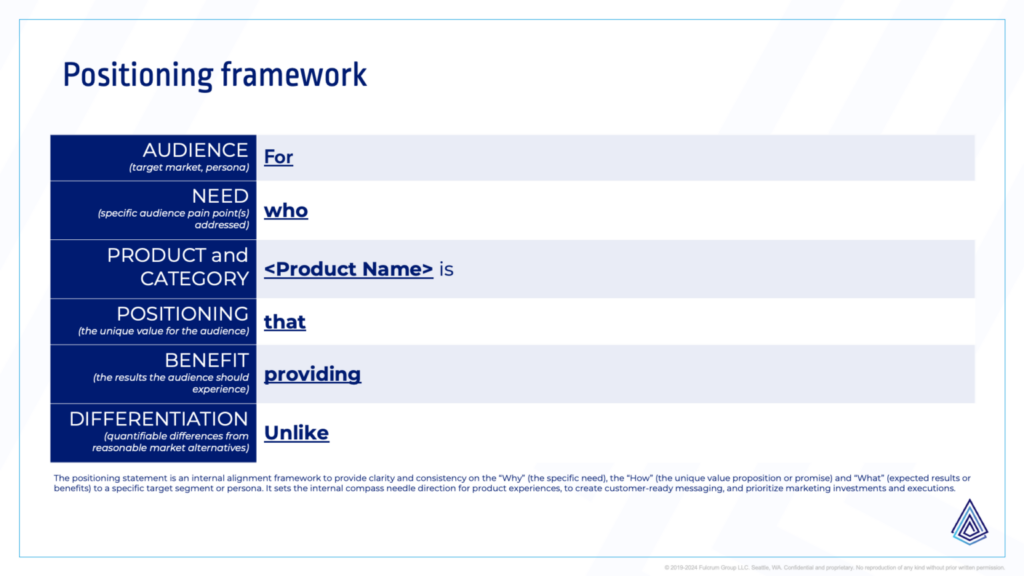The power of positioning cannot be overstated.
If you’re struggling to accelerate your go-to-market, it might be time to consider a shift in your product positioning.
In this blog post, we’ll explore a 6-step positioning framework we’ve developed specifically for B2B tech products. We’ll also show you how to use this framework with a real-world example.
Before we dive in, let’s look at how Stanley, an outdoor gear manufacturer, leveraged the power of positioning to accelerate sales.
A case study on positioning
For decades, Stanley positioned its well-known tumbler as a rugged, masculine thermos. As a result, the “Cup” built significant mindshare with one clear target audience.
However, when Terrence Reilly came on as CMO in 2020, he decided to shake things up.
“It’s an iconic brand, iconic product, but there was a big opportunity to reposition the brand and appeal to new consumers,” said Reilly, “and that’s just what we set out to do.”
Thanks to some enterprising influencers who were members of this new target audience, Reilly was inspired to re-position the “Quencher.”
Reilly flipped the script for Stanley’s 40-ounce tumbler. He repositioned the product promise and target audience to market it to 25- to 50-year-old women.
Suddenly, Stanley’s tumbler went from being barely considered by this audience to being positioned as “the Cup” for everyday use.
The result?
Stanley accelerated annual sales from $75 million a year to $750 million a year in 2023.
Stanley’s success serves as a compelling testament to the transformative power of strategic positioning to accelerate sales, revenue, and product adoption.
While Stanley made it look easy, positioning can often be hard to get right.
With that in mind, let’s discuss exactly what positioning is – and what it is not – to lay the important groundwork for our 6-step approach.
Understanding positioning
Positioning is NOT what you do to a product. It’s what you do to the mind of the prospect. You position the product in the mind of your prospect.
A positioning statement is an alignment framework to clarify the “Why” (the specific need), the “How” (the unique value proposition or promise), and “What” (expected results or benefits) for a target segment or buyer persona.
Your positioning framework sets an internal compass needle direction for your product experiences. This allows you to craft customer-ready messaging and prioritize marketing investments and execution.
Positioning is NOT:
- Customer-facing: Positioning is for internal eyes only. It is not meant to be put in front of a customer.
- Overly word-smithed: Use plain, understandable language. This is generally a good rule of thumb for all marketing assets.
- Ever-changing nor forever static: Your positioning is not something you’ll edit every day. Instead, it should be revisited as you learn more about your target audience.
- One and done: There’s no such thing as a “one-size fits all” with positioning. To avoid making your positioning too generic, consider developing separate ones for different types of audiences or verticals.
- About you or your product: Be sure to keep your positioning customer-centric. It should not focus on your product but on the value you provide your audience versus reasonable alternatives.
The 6-step positioning framework
As a tech marketing firm, we’ve had the opportunity to apply this proven framework with numerous B2B tech clients, gaining valuable insights along the way.

Step 1: Audience
Pinpoint the target market or persona.
Be sure to target one clear audience. If you need to target additional audiences, consider creating separate positioning statements.
Step 2: Name their pain and thus their need
Speak to your audience’s specific pain points.
Keep in mind this should be from the perspective of your customer’s current worldview, not the worldview of your product.
Step 3: Product and category
Using very clear and even plain language, explain what your product is or does. It should be evident and not heavily nuanced. Remember, this does not go in front of a customer, so don’t overly wordsmith it.
Step 4: Positioning
Articulate your unique value for the audience.
Differentiate this from the benefits by focusing on how your product achieves the desired outcomes rather than the outcomes themselves. For example, if the benefit is time-savings, be clear about how those time-savings are achieved.
Step 5: Benefit
Define the results the audience should experience.
This is NOT about your technical product features and how they work. It is how those features ultimately make life easier or smoother for your audience. In business, benefits usually always ladder up to time or cost savings.
Step 6: Differentiation
Quantify the differences from reasonable market alternatives.
When considering your differentiation, remember that your number one competitor is often the status quo. Always consider your differentiation with an eye on this fact versus only focusing on named marketplace competitors.
Positioning example
Let’s explore the practical application of our 6-step positioning framework with a real-world example.
We crafted a positioning statement for Square, the financial services platform founded in 2009. Though Square has numerous products at this point, we’ll use their Terminal product for our example.
| Audience | For small and medium-sized business owners conducting face-to-face point of sale (POS) transactions |
| Need | who need to accept payments quickly and easily from anywhere while giving customers a smooth payment experience |
| Product and Category | Square Terminal is an all-in-one device for taking card payments and printing receipts |
| Positioning | that provides the immediate convenience of accepting credit card payments |
| Benefit | providing a fast, frictionless purchasing experience for your customers without impacting margins |
| Differentiation | unlike stationary payment POS systems, Square Terminal has a long-lasting battery, cordless design, and built-in receipt printer so it can be carried around the store. |
Nail your positioning
Stanley’s “Quencher” product showed how the power of positioning can accelerate sales, revenue, and product adoption.
If you’re struggling to accelerate your go-to-market, it might be time to consider a shift in positioning.
Our 6-step positioning framework has been honed through our collaboration with numerous B2B tech clients. By embracing the principles and practices outlined in this framework, you can nail your positioning to start accelerating your go-to-market.
Need help standing out from the competition? We are here to help you!
Fulcrum is an instant-on tech marketing firm that helps B2B tech companies accelerate. Accelerate sales, accelerate revenue, and accelerate adoption.
To get started, schedule a no-obligation, 15-minute call with us today.


